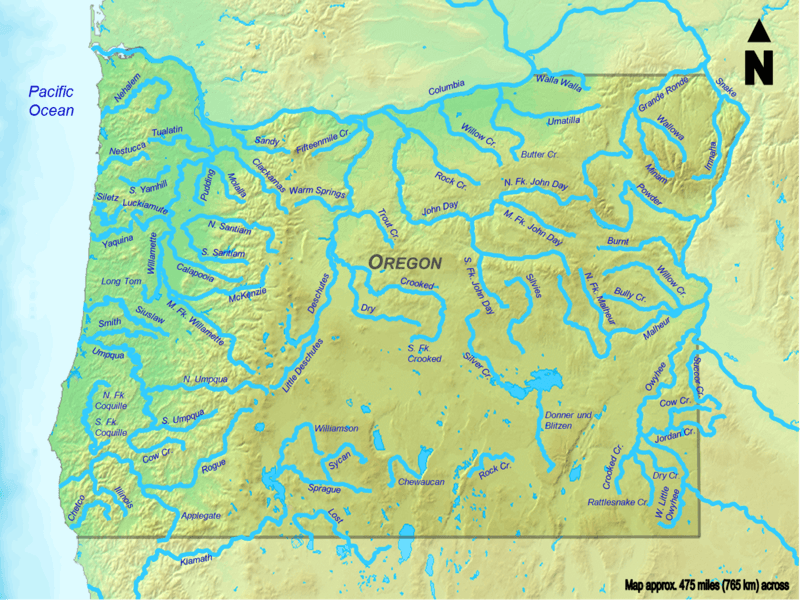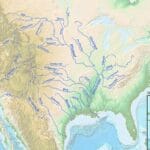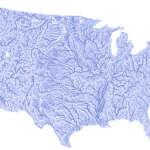Join us on an unforgettable voyage down Oregon’s longest river, an epic waterway that has not only shaped the state’s landscape but also its history and culture. From its humble beginnings in the craggy Rocky Mountains to its grand finale where it meets the mighty Pacific, the Columbia River unfolds a breathtaking vista of natural wonders and fascinating tales. Get ready to discover hidden treasures, unravel intriguing secrets, and marvel at the unparalleled beauty of Oregon’s longest river.
Oregon’s Longest Riverine Gem: Delving into the Longest River in Oregon
When discussing the longest river in Oregon, the mighty Columbia River, which traverses multiple states, often steals the spotlight. However, nestled within Oregon’s borders lies a hidden gem: the John Day River. This impressive waterway meanders for approximately 284 miles, rightfully claiming the title of the longest river entirely contained within Oregon.
What distinguishes the John Day River even further is its untamed nature. It flows freely along its entire course, earning the distinction of being the third-longest free-flowing river in the contiguous United States. This lack of dams makes it a rare treasure in a world where rivers are often harnessed for human needs.
While 284 miles might pale in comparison to the Columbia’s grandeur, the John Day River compensates with its unique character. It offers a captivating journey through diverse landscapes, showcasing the raw beauty of Oregon’s wilderness. Imagine pristine waters winding through rugged canyons, painted in shades of ochre and gold, echoing with the whispers of the past.
The John Day River isn’t merely a scenic wonder; it’s a lifeline for Oregon’s ecosystem. Its clear, clean waters teem with life, providing a vital habitat for a rich variety of plants and animals. Anglers are particularly drawn to its abundant fish populations, hoping to land a prized steelhead trout or a mighty Chinook salmon.
Beyond fishing, the John Day River is a paradise for outdoor enthusiasts of all kinds. Adventure seekers can navigate its exhilarating rapids on a whitewater rafting trip, while those seeking a more tranquil experience can glide along its calmer stretches in a kayak, soaking in the breathtaking scenery.
While the John Day River stands as the longest, Oregon boasts a network of captivating rivers, each with its own unique charm. The Willamette River, for instance, gracefully winds its way through the heart of Portland, a testament to nature’s presence even in urban landscapes. Then there are the Umpqua and Rogue Rivers, renowned for their wild beauty and challenging rapids. Each river contributes to the intricate tapestry of Oregon’s waterways, making it a true paradise for anyone drawn to the allure of flowing water.
Why not venture beyond the familiar and discover the hidden wonders of the John Day River? Immerse yourself in its beauty, experience its tranquility, and leave with a newfound appreciation for the natural treasures that Oregon so generously offers. Your adventure awaits!
What Defines the Longest River in Oregon?
We’ve established that the John Day River holds a significant title in Oregon. But what exactly determines the “longest river”? Is it as straightforward as measuring a straight line from its beginning to its end? The answer, as is often the case in nature, is a bit more nuanced.
Determining a river’s length can involve different approaches. Some argue that every twist and turn, every meander along its course, should be factored into the total distance. Others believe that measuring the straight-line distance between a river’s source (where it originates) and its mouth (where it empties into another body of water) is a more accurate representation of its length. It’s akin to choosing between measuring the distance along a winding road versus drawing a straight line between two points on a map.
In the case of the John Day River, its impressive 284-mile journey is measured by following its natural path with all its curves and bends. This meandering journey contributes to the river’s unique character and ecological significance. Imagine a ribbon effortlessly flowing across the landscape; that’s the John Day River, tracing its way through Oregon’s diverse terrain.
The John Day River’s significance extends beyond its impressive length. This free-flowing wonder, unobstructed by dams along its main course, supports a level of biodiversity and ecological resilience that is increasingly rare in our world. The river’s natural flow regime, undisturbed by human-made barriers, allows for the natural fluctuation of water levels, creating a dynamic environment that benefits a wide array of species.
This wild character is not only crucial for wildlife but also provides a unique opportunity for outdoor enthusiasts to experience the raw beauty of a truly untamed river. Whether it’s the thrill of navigating rapids, the serenity of a quiet fishing spot, or the awe-inspiring views from a hiking trail overlooking the canyon, the John Day River offers a chance to connect with nature on its own terms.
Key Takeaways:
- The John Day River’s 284-mile length is measured along its sinuous path, encompassing all its natural curves and turns.
- It stands as the third-longest free-flowing river in the contiguous United States, a testament to its wild and untamed nature.
- The river’s journey through diverse landscapes, from rugged mountains to serene valleys, showcases the remarkable beauty and ecological diversity of Oregon.
- Its free-flowing status makes it a vital habitat for a wide array of fish and wildlife, contributing to the overall health of the ecosystem.
- The John Day River offers a wealth of recreational opportunities, attracting visitors from all walks of life who seek adventure and connection with nature.
- Preserving undammed rivers like the John Day is essential for maintaining ecological balance and ensuring the long-term health of our planet.
Exploring the Course of Oregon’s Longest River
We’ve delved into the John Day River’s impressive length and free-flowing nature, but let’s embark on a virtual journey to explore the remarkable features that define its course. Get ready to uncover the stories etched into the landscape, encounter the vibrant life sustained by its waters, and discover the allure that draws adventurers to its shores.
Geological Grandeur
Imagine the John Day River, originating from snowmelt and springs high in the Malheur National Forest, beginning its incredible journey. Over eons, this river has acted as a master sculptor, steadily carving its path through millions of years of layered rock. As it flows, it reveals a hidden history of volcanic eruptions, ancient floods, and the slow, powerful forces that have shaped the very ground we stand on.
Standing on the rim of a canyon, gazing down at the John Day River snaking through the bottom, one can’t help but marvel at the power of nature. The towering cliffs, mesas, and buttes that define the landscape are testaments to the river’s relentless work over time. Each curve and bend in the river’s course whispers tales of geological processes unfolding over millennia.
Ecological Tapestry
Beyond its geological wonders, the John Day River teems with life, supporting a vibrant ecosystem that thrives on its life-giving waters. Fish, including iconic species like salmon and steelhead, rely on this river to complete their incredible upstream journeys to spawn. Birds of prey, such as the majestic bald eagle, soar overhead, their keen eyes scanning the water for a glimpse of their next meal. The riverbanks are abuzz with activity, providing refuge for deer, otters, beavers, and a host of other creatures that call this riparian corridor home.
Recreational Paradise
The John Day River’s untamed beauty and diverse landscapes make it a recreational paradise. Imagine yourself grabbing a paddle and navigating through exhilarating whitewater rapids, the rush of adrenaline coursing through you as you conquer each turn. For those seeking a more tranquil experience, casting a line into a crystal-clear fishing hole offers a chance to unwind and connect with nature’s rhythm. And don’t forget about the miles of hiking trails that wind through forests and along the canyon rims, offering breathtaking views that stretch as far as the eye can see. Whether you crave heart-pumping adventure or peaceful solitude, the John Day River has something to offer every outdoor enthusiast.
Cultural Heritage
The John Day River isn’t merely a natural wonder; it’s a living testament to human history, intrinsically linked to the cultures and communities that have thrived along its banks for centuries. Native American tribes, including the Warm Springs, Wasco, and Paiute peoples, have long considered this river to be an integral part of their ancestral lands. They fished its waters, hunted in the surrounding lands, and built their homes near its banks, their lives deeply intertwined with the river’s rhythm. Evidence of their presence can still be found in the names of places and the echoes of their stories whispered through the canyons.
Key Takeaways:
- Oregon’s Longest: No other river can claim the title of Oregon’s longest while staying entirely within the state’s borders. The John Day River reigns supreme!
- Undammed Jewel: In a world where rivers are often dammed for various reasons, the John Day flows freely for most of its length, a testament to the importance of preserving natural waterways.
- Geological Masterpiece: Every bend in the river, every towering cliff, tells a story of Earth’s incredible history. It’s like flipping through the pages of a geology textbook, but way more exciting!
- Ecological Sanctuary: The John Day River reminds us that everything is connected. The health of the river directly impacts the plants, animals, and people who rely on it.
- Outdoor Playground: Whether you’re seeking thrills or tranquility, the John Day River offers endless opportunities to connect with nature and create unforgettable memories.
The John Day River’s story is vast and ever-unfolding. We encourage you to delve deeper and uncover the hidden gems within this remarkable ecosystem. Research the river’s unique geology, discover the stories of the people who have called this area home for generations, or explore the diverse species that thrive within its waters. Who knows what other secrets this magnificent river holds?
The Ecological Significance of Oregon’s Longest River
The John Day River, far from being just a scenic wonder, functions as a vital artery within a complex and interconnected ecosystem. Its undammed status allows it to flow naturally for 281 miles, creating a diverse array of habitats that support a wealth of plant and animal life. Think of it as a haven for biodiversity, a refuge for creatures big and small, from the iconic steelhead trout and Chinook salmon to the less conspicuous but equally important insects, amphibians, and reptiles that contribute to the intricate web of life.
One of the John Day River’s most significant ecological contributions is its role in supporting healthy fish populations. As a free-flowing river, it provides essential spawning grounds for migratory fish like salmon and steelhead, which journey from the ocean upstream to their natal waters to reproduce. The river’s natural flow regime allows for the creation of gravel beds, essential for successful spawning, and the constantly changing water levels ensure that nutrients are distributed throughout the system, benefiting a myriad of aquatic organisms.
The John Day River’s undammed state also allows for natural fluctuations in water flow, which, while seemingly chaotic, are crucial for maintaining a healthy river ecosystem. These fluctuations create a mosaic of habitats, each with its own unique characteristics. Side channels, backwaters, and riparian zones all contribute to the overall diversity of the river system, providing homes and resources for a wider variety of plants and animals.
Let’s not forget about the rocks! The John Day River, cutting through the landscape, exposes layers of colorful canyons and cliffs, providing a visual feast for geology enthusiasts. These formations aren’t just aesthetically pleasing; they play a vital role in the ecosystem as well. Canyon walls provide nesting sites for birds of prey, while rocky outcrops along the riverbank offer basking spots for reptiles. These geological features add to the complexity and biodiversity of the John Day River ecosystem.
And beyond its ecological and recreational benefits, the John Day River plays a role in powering Oregon’s communities. As a source of hydroelectric power, it contributes to the production of clean, renewable energy, demonstrating that economic development and environmental stewardship can go hand in hand.
Here’s a closer look at what makes the John Day River so ecologically significant:
- It’s wild and free! As the longest free-flowing river in Oregon, the John Day supports a more diverse and resilient ecosystem than dammed rivers. It provides crucial habitat for a wide array of fish and wildlife species, many of which are migratory and depend on the river’s natural flow regime to complete their life cycles.
- It’s a playground for outdoor enthusiasts. Fishing, rafting, camping – the John Day River offers a little something for everyone who loves to experience nature. Its undammed status ensures a more pristine and secluded experience, allowing visitors to truly immerse themselves in the beauty of Oregon’s wilderness.
- It’s officially a National Wild and Scenic River. This special designation, bestowed upon only a select few American rivers, helps protect the river and its surroundings for future generations. The designation recognizes the John Day River’s outstanding natural, cultural, and recreational values and ensures that it will continue to flow freely for years to come.
- It’s a time machine for geology buffs. The canyons and cliffs along the river offer a captivating glimpse into the geological processes that have shaped Oregon’s landscape over millions of years. Each layer of rock tells a story of volcanic eruptions, ancient floods, and the powerful forces that continue to mold our planet.
- It’s a clean energy source. The John Day River contributes to Oregon’s renewable energy portfolio by providing a source of hydroelectric power. This clean energy production helps reduce reliance on fossil fuels and minimizes the state’s carbon footprint.
The John Day River stands as a powerful reminder that protecting our wild places is not just an act of environmental stewardship, but an investment in our future. By preserving free-flowing rivers like the John Day, we ensure that future generations will have the opportunity to experience the awe-inspiring beauty, ecological richness, and recreational opportunities that these natural treasures provide.
Discover the top 10 states with the most rivers in the United States and explore the fascinating waterways that shape their landscapes. And delve into the majestic flow of the three longest rivers in the United States, revealing their historical significance and ecological importance.
- Guatemala vs. Costa Rica: Plan Your Trip Smartly - April 16, 2025
- Master Types of Pumps: Ultimate Guide to Selection - April 16, 2025
- Unlock Types of Makeup Secrets: Master Any Look Now - April 16, 2025
















